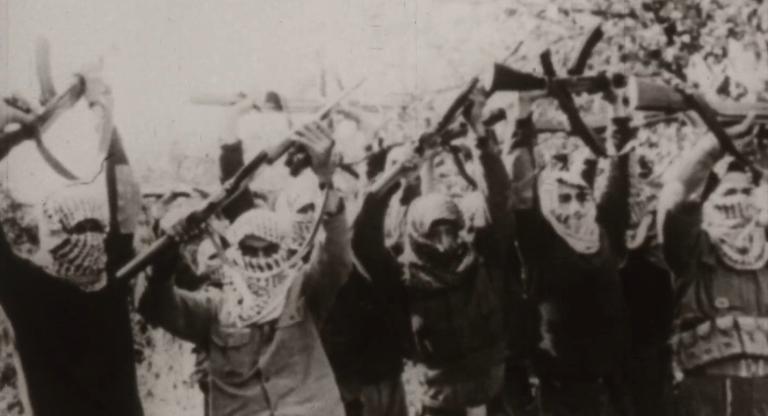
CG: Could you describe the transition of working on television reporting to directing your own protect and having control over all the creative decision making?
DE: My experience producing and directing current affairs and news documentaries for television was a great training ground for Los Sures in many respects. I knew the Puerto Rican communities in New York and I had done stories of many similar situations in New York and around the country, often covering the problems many neighborhoods were facing with unemployment, insecurity, lack of key government support in key services, etc. I had witnessed the challenges those communities were facing in the late 1970's and early 80's. That is what in many ways drove me to make Los Sures . Yet at the same time I did not want to do another reporting story and felt the need for a much more personal approach to exploring what was going on inside those neighborhoods. So I knew early on the only option was to do this for PBS. Fortunately, there was a funding and programming source at WNET where projects could be submitted. That was the Non Fiction Television Fund directed by David Loxton, a wonderful Executive Producer who allowed support in those years for many filmmakers and for projects such as Los Sures .

DE: The film was a very unique experience because it allowed to explore with greater depth many situations and people that were particularly close to me, because of my background of having grown in Puerto Rico and witnessing in New York a very vibrant Puerto Rican community. Funding for this kind of documentaries became increasingly difficult and little by little television started changing in scope and nature, as did the Williamsburg section of Brooklyn.

CG: How did you meet Tito, Marta, Ana María, Cuso, and Evelyn?
DE: We met most of the people in the film by spending time in the neighborhood, walking the streets and engaging people on a one-to-one basis to tell us about themselves. It was slow process taking several weeks of staying fit in certain key blocks so people would get to know me and [associate producer] Fernando Moreno, be able to trust us and understand the nature of the project we were making. Then after a while, when we brought our small crew, we had already selected a few people and we were no longer complete strangers. Often people would approach us to tell us what was going on, would tell us who we should meet and direct us in certain directions. That is how we got to meet most of the people in the film, knowing before hand we wanted contrasting stories of people bringing different experiences, different views of the neighborhood, different challenges in their personal lives.
Fernando Moreno, Echeverria’s associate producer, was a prominent journalist within the Latino community. Moreno worked as the editor of El Diario La Prensa, which covered the Rican community in New York, drug trafficking, and, boldly, the 1978 Cerro Maravilla case in Puerto Rico, in which several police officers accused of murdering two pro-independence activists were declared “heroic” by the Governor in a televised broadcast.
In conversation, Echeverria briefly suggests that Oscar Lewis’ 1966 book La Vida: A Puerto Rican Family in the Culture of Poverty—San Juan and New Yorkhas been profoundly influential in his overall work because of its fluid, conversational style. The influence is borne out by Echeverria’s natural interview sequences throughout the film, complemented by contemplative shots of the neighborhood as it was. Cultural markers are present throughout the film: el pirag ü ero , the impromptu street bolero performance (Julio Jaramillo’s Odiame ); the opening of a fire hydrant on a hot summer day; the dancing of kids to Menudo’s “Coquí” (“ No hay nadie que ame tanto a nuestro país”) , a graffiti alluding to the Puerto Rico’s decolonization committee at the UN, at the anniversary of the Lares Revolt. One beautiful shot from a camera positioned at the interior of a car zooms into Tito handing his buddy a ruby red coke can to the Esquina Boricua bodega storefront proudly boasting the Puerto Rican flag. Questioned about its execution, Echeverria snappily responds, “That you get from experience, Carolina!,” humbly going on to extol his crew’s masterful skill, crediting his multi-ethnic team name by name. In response to a question about his reaction to the recovery and preservation of Los Sures , undertaken by the New York Public Library and UnionDocs, he jolts: “That never happens!”

DE: It was a process of many twists and turns, originals lost by the lab that had long closed, tracking existing prints, etc. Since the film was completed I had gone to many other projects, I had moved to Latin America for several years and the film was getting distributed in DVD. We took for granted [that] the film elements were safe and they were not. Fortunately, we were able to find a 16mm copies [copy] in very good shape and the preservation was completed successfully after a lot of hard work and the commitment of several wonderful people.
The newly surged revival ofLos Sures hopefully points to an insistent recovery of Latino media makers, and to a rewriting of a history that includes and makes their work more visible and present. Los Sures is really one in a slew of very few documentaries that offers a real, empathic and respectful portrayal of the Puerto Rican community in NYC, do not miss out on the opportunity to see it exalted and dignified on a large screen.


